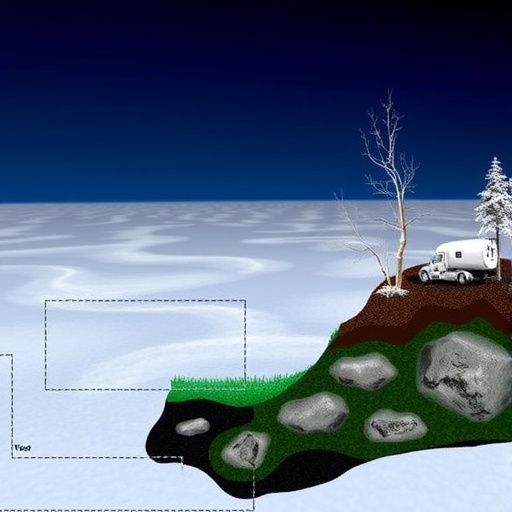Thawing permafrost has long been recognized as a significant driver of climate change, primarily because of the vast reservoirs of carbon stored within its frozen layers. As global temperatures rise, abrupt thaw events release considerable quantities of greenhouse gases such as carbon dioxide and methane, amplifying the current climate crisis. Yet, recent groundbreaking research challenges this singular narrative by revealing a previously underappreciated microbial mechanism that may enhance carbon stabilization following abrupt permafrost thaw.
A team of researchers led by Professor YANG Yuanhe from the Institute of Botany at the Chinese Academy of Sciences has unveiled compelling evidence that microbial carbon use efficiency (CUE)—the fraction of carbon uptake that microbes convert into biomass as opposed to respiration—increases after the sudden thawing of permafrost soils. Published in the prestigious Proceedings of the National Academy of Sciences, their study delves into the intricate interplay between microbial physiology, soil chemistry, and thaw dynamics across the Tibetan Plateau, one of the world’s most climatically sensitive regions.
The research utilized an advanced substrate-independent ^18O-tracing technique to quantify microbial metabolic activity and precisely measure CUE across multiple stages of permafrost thaw. This innovative approach circumvents traditional limitations associated with substrate-specific assays, providing a more holistic and reliable assessment of microbial carbon partitioning under environmental stress. Soil samples spanning a complete permafrost thaw sequence—ranging from intact frozen soil to freshly thawed active layers—were analyzed, supplemented by data from five additional thaw-impacted sites across the Tibetan Plateau to corroborate regional consistency.
Results demonstrated a robust and consistent pattern: microbial communities in thawed soils exhibited higher CUE, meaning that a larger proportion of assimilated carbon was directed toward biomass production rather than being emitted as CO2 through respiration. This finding fundamentally alters the understanding of microbial roles in post-thaw carbon dynamics, suggesting that microbial communities shift towards more efficient carbon retention modes rather than simply accelerating greenhouse gas emissions.
Delving deeper into the microbial ecology underpinning this enhanced CUE, the researchers documented significant compositional shifts within the microbial assemblages. Specifically, a marked increase in the fungal-to-bacterial biomass ratio was observed, coupled with a proliferation of fast-growing microbial taxa adapted to the nutrient-rich environments created by thaw. Fungi, known for their more efficient carbon assimilation and ability to form complex soil organic compounds, appear to play a pivotal role in channeling carbon into stable soil pools.
Moreover, the study revealed that phosphorus availability—a critical nutrient that often limits microbial growth—significantly increased in thawed soils. The abrupt release of otherwise inaccessible soil phosphorus enhances microbial growth rates and metabolic efficiency, further driving up CUE. This synergy between nutrient availability and microbial community composition appears to be a key mechanism by which microbial carbon stabilization is augmented in the wake of thaw.
Traditionally, abrupt permafrost thaw has been considered a net loss to global carbon stocks, locking scientists into a dire feedback loop where thaw-induced greenhouse gas emissions accelerate climate warming, which in turn exacerbates thaw. However, this novel research introduces a more nuanced perspective: microbial communities may be critical mediators that partially buffer this carbon release by diverting a portion of carbon into more stable microbial biomass and derivative soil organic matter.
The implications of these findings are profound, potentially reshaping global climate models that currently do not fully integrate dynamic microbial physiological responses. Incorporating microbial CUE, community shifts, and nutrient-mediated feedbacks could substantially refine predictions of permafrost carbon release trajectories and their implications for climate feedback loops. These insights underscore the importance of soil microbial ecology within the broader Earth system context.
Furthermore, the research highlights the value of interdisciplinary approaches that blend microbiology, soil chemistry, and advanced isotopic tracing—a methodology that can be applied across other vulnerable ecosystems undergoing rapid environmental change. The Tibetan Plateau, serving as a case study, reinforces that regional variability in microbial responses must be accounted for to produce globally relevant data.
This study invites a paradigm shift in permafrost research by emphasizing the emergent properties of microbial communities as bioengineers of soil carbon fate rather than mere bystanders in thaw events. It suggests that microbial ecology is not only central to understanding immediate greenhouse gas fluxes but also integral to long-term carbon sequestration mechanisms in permafrost-affected landscapes.
Overall, the discovery of increased microbial carbon use efficiency following abrupt permafrost thaw lends a glimmer of optimism amidst the otherwise bleak outlook for carbon emissions from thawing soils. It opens a promising avenue for continued research into microbial interventions and soil nutrient dynamics that could inform climate mitigation strategies targeting vulnerable high-latitude and high-altitude ecosystems.
In sum, the work of Professor YANG and colleagues adds a vital piece to the complex puzzle of permafrost carbon cycling by illuminating how microbial physiological adaptations and community restructuring serve as intrinsic controls on carbon fate. As climate warming accelerates, understanding and harnessing such microbial feedbacks will be crucial for anticipating and managing earth system responses in a rapidly changing world.
Subject of Research:
Not applicable
Article Title:
Increased microbial carbon use efficiency upon abrupt permafrost thaw
News Publication Date:
12-Aug-2025
Web References:
http://dx.doi.org/10.1073/pnas.2419206122
References:
Proceedings of the National Academy of Sciences, 10.1073/pnas.2419206122
Image Credits:
Credit: QIN Shuqi
Keywords:
Permafrost, Abrupt climate change, Microbial ecology, Soil carbon, Microbiology




